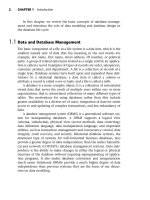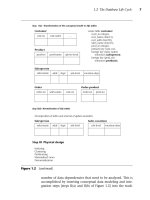Database Modeling & Design Fourth Edition- P37 ppsx
Bạn đang xem bản rút gọn của tài liệu. Xem và tải ngay bản đầy đủ của tài liệu tại đây (169.62 KB, 5 trang )
8.2 Online Analytical Processing (OLAP) 167
ing them in step with the fact tables as new data arrives. When a user
requests summary data, the OLAP system figures out which AST can be
used for a quick response to the given query. OLAP systems are a good
solution when there is a need for ad hoc exploration of summary infor-
mation based on large amounts of data residing in a data warehouse.
OLAP systems automatically select, maintain, and use the ASTs.
Thus, an OLAP system effectively does some of the design work auto-
matically. This section covers some of the issues that arise in building an
OLAP engine, and some of the possible solutions. If you use an OLAP
system, the vendor delivers the OLAP engine to you. The issues and solu-
tions discussed here are not items that you need to resolve. Our goal
here is to remove some of the mystery about what an OLAP system is
and how it works.
8.2.1 The Exponential Explosion of Views
Materialized views aggregated from a fact table can be uniquely identi-
fied by the aggregation level for each dimension. Given a hierarchy
along a dimension, let 0 represent no aggregation, 1 represent the first
level of aggregation, and so on. For example, if the Invoice Date dimen-
sion has a hierarchy consisting of date id, month, quarter, year and “all”
(i.e., complete aggregation), then date id is level 0, month is level 1,
quarter is level 2, year is level 3, and “all” is level 4. If a dimension does
not explicitly have a hierarchy, then level 0 is no aggregation, and level
1 is “all.” The scales so defined along each dimension define a coordi-
nate system for uniquely identifying each view in a product graph. Fig-
ure 8.13 illustrates a product graph in two dimensions. Product graphs
are a generalization of the hypercube lattice structure introduced by
Harinarayan, Rajaraman, and Ullman [1996], where dimensions may
have associated hierarchies. The top node, labeled (0, 0) in Figure 8.13,
represents the fact table. Each node represents a view with aggregation
levels as indicated by the coordinate. The relationships descending the
product graph indicate aggregation relationships. The five shaded nodes
indicate that these views have been materialized. A view can be aggre-
gated from any materialized ancestor view. For example, if a user issues a
query for rows grouped by year and state, that query would naturally be
answered by the view labeled (3, 2). View (3, 2) is not materialized, but
the query can be answered from the materialized view (2, 1) since (2, 1)
is an ancestor of (3, 2). Quarters can be aggregated into years, and cities
can be aggregated into states.
Teorey.book Page 167 Saturday, July 16, 2005 12:57 PM
168 CHAPTER 8 Business Intelligence
The central issue challenging the design of OLAP systems is the
exponential explosion of possible views as the number of dimensions
increases. The Calendar dimension in Figure 8.13 has five levels of hier-
archy, and the Customer dimension has four levels of hierarchy. The
user may choose any level of aggregation along each dimension. The
number of possible views is the product of the number of hierarchical
levels along each dimension. The number of possible views for the
example in Figure 8.13 is 5 × 4 = 20. Let d be the number of dimensions
in a data warehouse. Let h
i
be the number of hierarchical levels in
dimension i. The general equation for calculating the number of possi-
ble views is given by Equation 8.1.
Possible views = 8.1
If we express Equation 8.1 in different terms, the problem of expo-
nential explosion becomes more apparent. Let g be the geometric mean
Figure 8.13 Product graph labeled with aggregation level coordinates
Calendar Dimension
(first dimension)
0: date id
1: month
2: quarter
3: year
4: all
Customer Dimension
(second dimension)
0: cust id
1: city
2: state
3: all
(0, 0)
(1, 0) (0, 1)
(1, 1) (0, 2)
(1, 2) (0, 3)
(1, 3)
(2, 0)
(2, 1)
(2, 2)
(2, 3)
(3, 0)
(3, 1)
(3, 2)
(3, 3)
(4, 0)
(4, 1)
(4, 2)
(4, 3)
Fact Table
h
i
i 1=
d
∏
Teorey.book Page 168 Saturday, July 16, 2005 12:57 PM
8.2 Online Analytical Processing (OLAP) 169
of the number of hierarchical levels in the dimensions. Then Equation
8.1 becomes Equation 8.2.
Possible views = g
d
8.2
As dimensionality increases linearly, the number of possible views
explodes exponentially. If g = 5 and d = 5, there are 5
5
= 3,125 possible
views. Thus if d = 10, then there are 5
10
= 9,765,625 possible views.
OLAP administrators need the freedom to scale up the dimensionality of
their data warehouses. Clearly the OLAP system cannot create and main-
tain all possible views as dimensionality increases. The design of OLAP
systems must deliver quick response while maintaining a system within
the resource limitations. Typically, a strategic subset of views must be
selected for materialization.
8.2.2 Overview of OLAP
There are many approaches to implementing OLAP systems presented in
the literature. Figure 8.14 maps out one possible approach, which will
serve for discussion. The larger problem of OLAP optimization is broken
into four subproblems: view size estimation, materialized view selection,
materialized view maintenance, and query optimization with material-
ized views. This division is generally true of the OLAP literature, and is
reflected in the OLAP system plan shown in Figure 8.14.
We describe how the OLAP processes interact in Figure 8.14, and
then explore each process in greater detail. The plan for OLAP optimiza-
tion shows Sample Data moving from the Fact Table into View Size Esti-
mation. View Selection makes an Estimate Request for the view size of each
view it considers for materialization. View Size Estimation queries the
Sample Data, examines it, and models the distribution. The distribution
observed in the sample is used to estimate the expected number of rows
in the view for the full dataset. The Estimated View Size is passed to View
Selection, which uses the estimates to evaluate the relative benefits of
materializing the various views under consideration. View Selection picks
Strategically Selected Views for materialization with the goal of minimiz-
ing total query costs. View Maintenance builds the original views from
the Initial Data from the Fact Table, and maintains the views as Incremen-
tal Data arrives from Updates. View Maintenance sends statistics on View
Costs back to View Selection, allowing costly views to be discarded
dynamically. View Maintenance offers Current Views for use by Query Opti-
mization. Query Optimization must consider which of the Current Views
Teorey.book Page 169 Saturday, July 16, 2005 12:57 PM
170 CHAPTER 8 Business Intelligence
can be utilized to most efficiently answer Queries from Users, giving
Quick Responses to the Users. View Usage feeds back into View Selection,
allowing the system to dynamically adapt to changes in query work-
loads.
8.2.3 View Size Estimation
OLAP systems selectively materialize strategic views with high benefits
to achieve quick response to queries, while remaining within the
resource limits of the computer system. The size of a view affects how
much disk space is required to store the view. More importantly, the size
of the view determines in part how much disk input/output will be con-
sumed when querying and maintaining the view. Calculating the exact
size of a given view requires calculating the view from the base data.
Reading the base data and calculating the view is the majority of the
work necessary to materialize the view. Since the objective of view mate-
rialization is to conserve resources, it becomes necessary to estimate the
size of the views under consideration for materialization.
Cardenas’ formula [Cardenas, 1975] is a simple equation (Equation
8.3) that is applicable to estimating the number of rows in a view:
Figure 8.14 A plan for OLAP optimization
Fact Table
Updates
Sample Data
Estimated
View Size
Strategically
Selected Views
Current Views
Incremental Data
Queries
Quick Responses
Estimate
Request
View Size Estimation
View Selection
View Maintenance
Initial Data
View Usage
Users Query Optimization
View Costs
Teorey.book Page 170 Saturday, July 16, 2005 12:57 PM
8.2 Online Analytical Processing (OLAP) 171
Let n be the number of rows in the fact table.
Let v be the number of possible keys in the data space of the view.
Expected distinct values = v(1 – (1 – 1/v)
n
)8.3
Cardenas’ formula assumes a uniform data distribution. However,
many data distributions exist. The data distribution in the fact table
affects the number of rows in a view. Cardenas’ formula is very quick,
but the assumption of a uniform data distribution leads to gross overesti-
mates of the view size when the data is actually clustered. Other meth-
ods have been developed to model the effect of data distribution on the
number of rows in a view.
Faloutsos, Matias, and Silberschatz [1996] present a sampling
approach based on the binomial multifractal distribution. Parameters of
the distribution are estimated from a sample. The number of rows in the
aggregated view for the full data set is then estimated using the parame-
ter values determined from the sample. Equations 8.4 and 8.5 [Faloutsos,
Matias, and Silberschatz, 1996] are presented for this purpose.
Expected distinct values = 8.4
P
a
= P
k–a
(1 – P)
a
8.5
Figure 8.15 illustrates an example. Order k is the decision tree depth.
C
k
a
is the number of bins in the set reachable by taking some combina-
tion of a left hand edges and k – a right hand edges in the decision tree.
P
a
is the probability of reaching a given bin whose path contains a left
hand edges. n is the number of rows in the data set. Bias P is the proba-
bility of selecting the right hand edge at a choice point in the tree.
The calculations of Equation 8.4 are illustrated with a small example.
An actual database would yield much larger numbers, but the concepts
and the equations are the same. These calculations can be done with log-
arithms, resulting in very good scalability. Based on Figure 8.15, given
five rows, calculate the expected distinct values using Equation 8.4:
Expected distinct values =
1 ⋅ (1 – (1 – 0.729)
5
) + 3 ⋅ (1 – (1 – 0.081)
5
) +
3 ⋅ (1 – (1 – 0.009)
5
) + 1 ⋅ (1 – (1 – 0.001)
5
) ≈1.965 8.6
C
a
k
11P
a
–()
n
–()
a 0=
k
∑
Teorey.book Page 171 Saturday, July 16, 2005 12:57 PM









